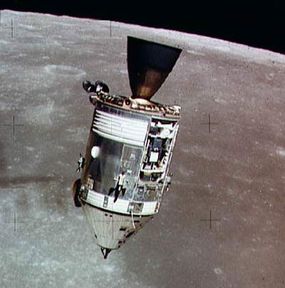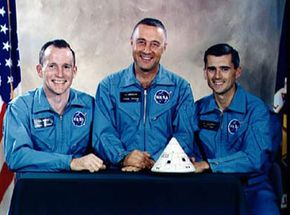The History of the Apollo Program
Over the span of the Apollo program, NASA conducted 33 flights. The earliest flights didn't carry human crews and were meant to test the launch vehicle and the Apollo spacecraft before attempting a lunar mission. NASA officially named 15 of the 33 flights Apollo. Eleven of these Apollo flights were manned. Six of the Apollo missions successfully landed men on the moon and returned them safely to Earth.
Here's a brief overview of the Apollo program:
Advertisement
- Missions SA-1 through SA-5: These unmanned missions tested the capabilities of the Saturn I launch vehicle. The Saturn I was a two-stage rocket that used liquid oxygen and kerosene for fuel.
- Missions A-101 through A-105: In these tests, a Saturn I launch vehicle carried a mockup of an Apollo spacecraft, called a boilerplate. Instruments in the boilerplate spacecraft measured the stresses astronauts and equipment would experience during a mission.
- Missions A-001 through A-004: A series of unmanned flights meant to test Apollo's mission abort procedures, including the launch escape system (LES).
- Missions AS-201 through AS-203: Three unmanned missions that tested the Saturn IB launch vehicle and Apollo spacecraft. The Saturn IB was an upgrade from the Saturn I. These flights also tested the propulsion systems onboard the Apollo spacecraft.
- Apollo 1, formerly AS-204: On Jan. 27, 1967, three astronauts died in a flash fire inside an Apollo spacecraft during a launchpad test. The test was meant to simulate launch conditions but not actually take off. Later, investigators cited the spacecraft's oxygen-rich environment and exposed wiring as possible causes of the fire. They also pointed out that engineers needed to redesign the spacecraft's exit hatch. NASA renamed the mission Apollo 1 in honor of Roger B. Chaffee, Virgil "Gus" Grissom and Edward H. White, the men who lost their lives in the fire.
- Apollo 4 through Apollo 6 (Note: NASA never designated any spacecraft with the name Apollo 2 or Apollo 3): These unmanned missions tested the Saturn V, the launch vehicle designed to propel the Apollo spacecraft into a lunar orbit.
- Apollo 7 through Apollo 10: The first manned Apollo missions, these flights tested the spacecraft's performance. Apollo 7 entered an Earth orbit for a few rotations before landing. Apollo 8 was the first manned spacecraft to enter a lunar orbit. During Apollo 9, astronauts tested the lunar module in space for the first time. Apollo 10 tested all of the systems and procedures necessary for a lunar landing, but didn't actually land on the moon.
- Apollo 11: Apollo 11 marked the first time a human set foot on the moon. The spacecraft's Lunar Module (LM) landed on the moon's surface on July 20, 1969.
- Apollo 12: The second lunar landing tested the spacecraft's ability to make a precise landing on the rocky lunar terrain.
- Apollo 13: This mission should have landed astronauts on the moon for the third time, but a malfunction 56 hours into the flight required the astronauts to abort the mission. Two of the spacecraft's oxygen tanks failed, and the Apollo's power system became unreliable. Remarkably, the astronauts onboard worked with mission operatives on Earth to land the spacecraft safely.

- Apollo 15 through Apollo 17: The final three Apollo missions tested the capabilities of astronauts and equipment in a more extensive stay on the moon's surface. NASA modified the spacecraft to carry an array of sensors and equipment, including a wheeled vehicle called the lunar rover.
Throughout the Apollo program, NASA refined the design of the launch vehicle and spacecraft. Covering every slight modification would require hundreds of pages, so in this article, we'll concentrate on the major systems all of the Apollo spacecraft had in common.
What were all the parts of the Apollo spacecraft? How did they fit together? Keep reading to find out.
